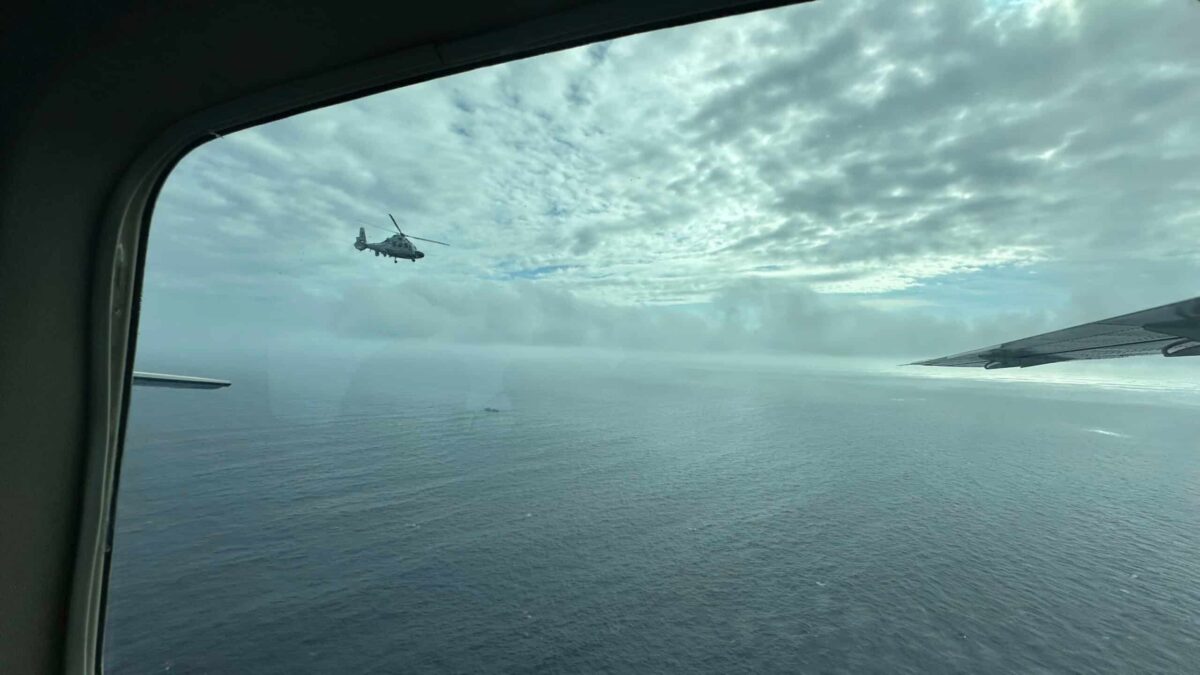West PH Sea: China wants to protect coral reefs in SCS; experts doubtful

A Chinese military helicopter flies close to a Philippine Bureau of Fisheries and Aquatic (BFAR) aircraft above Scarborough shoal on Feb. 18, 2025. FILE PHOTO/Associated Press
China’s declaration of a nature reserve in the South China Sea is the latest twist in its yearslong push to establish control over the strategically important waters and sea lane.
The National Forestry and Grassland Administration said last week that the reserve would protect the coral reef ecosystem at Huangyan Island, better known internationally as Scarborough Shoal. But outside experts believe the announcement was driven more by geopolitics than environmental protection.
The outcropping — a triangular chain of reef and rock with a fish-rich lagoon in the middle — is a hotly disputed territory that is also claimed by the Philippines and Taiwan.
READ: Corals worth P11M damaged by Chinese vessel off Pag-asa
Nature reserve builds on China’s control
China has effectively controlled Scarborough Shoal since a faceoff with the Philippines in 2012, though Philippine ships still try to approach it to stake the country’s claim.
Confrontations have spiked in recent years. In August, two Chinese ships collided while trying to intercept a Philippine ship near the shoal.
Before announcing the reserve, China earlier had declared the waters around the shoal as its territory and then published geographic coordinates defining what are known as the territory’s baselines.
READ: Experts say global effort needed to protect ecosystem in West PH Sea
“It falls into a pattern of China trying to establish administrative justifications for things it’s already done with military force,” Greg Poling, an expert on the South China Sea at the Center for Strategic and International Studies, said of the reserve.
Giant clam harvesting has damaged the coral
Scholars of environmental and marine science say that Chinese harvesting of giant clams, which was banned last year, has caused extensive damage to Scarborough Shoal. The shells have become popular and valuable in the last few decades as a replacement for elephant ivory, which has been increasingly banned.
Chinese ships dragged their propellers through the reefs to dig up the clams until 2016. Then they switched to firing high-pressure water at the reefs. The damage is less visible but equally harmful, said Ray Powell, founder and director of SeaLight, a group at Stanford University that tracks maritime “gray-zone” activity.
China is “attempting to strengthen its claim while diverting scrutiny from the environmental devastation its own fleets inflicted — like an arsonist who torches a property and then appoints himself fire marshal amid the ashes,” Powell said.
China eyes shift from defending to governing the shoal
The nature reserve has more to do with territorial claims than reef protection, said Bec Strating, a professor of international relations at La Trobe University in Australia. She described the move as “the weaponization of environmental concerns.”
China’s state broadcaster CCTV said the establishment of the reserve was not just an act of ecological protection, but also a signal that China is shifting from responding to provocations to long-term maritime governance in the South China Sea.
Marine scientists, including those from China, have been trying to preserve nature, but policymakers are turning conservation into politics, said James Borton, a non-resident senior fellow at Johns Hopkins’ SAIS Foreign Policy Institute.
“If you declare just a small section of the reef crest, maybe that’s an area where they can replant some coral and grow a little garden,” Poling said, “But Scarborough shoal is a graveyard … Everything is dead.”
Experts don’t see China building another island
China has come under criticism for island-building in the South China Sea, but experts don’t expect the same at Scarborough Shoal.
“It would be very odd for them to say we’re going to turn it into a nature preserve and then put a 3,000-meter (9,800-foot) concrete runway and four facilities there, right?” Powell said.
In 1995, China put up small octagonal huts on stilts at Mischief Reef in the Spratly Islands, another part of the South China Sea. The move alarmed the Philippines and others that claim the reef.
China said they were emergency shelters for fishers in bad weather, but in the ensuing years, it added a runway and other facilities that the U.S. has said turned the reef into a militarized island.
Building islands in the Spratlys makes more strategic sense, because they are farther from China’s shores than Scarborough Shoal, Poling said.
“China certainly doesn’t need an airstrip or another deep-water harbor there.” /dl
For comprehensive coverage, in-depth analysis, visit our special page for West Philippine Sea updates. Stay informed with articles, videos, and expert opinions.


















